The Great White Shark Scientist
Air Date: Week of June 24, 2016
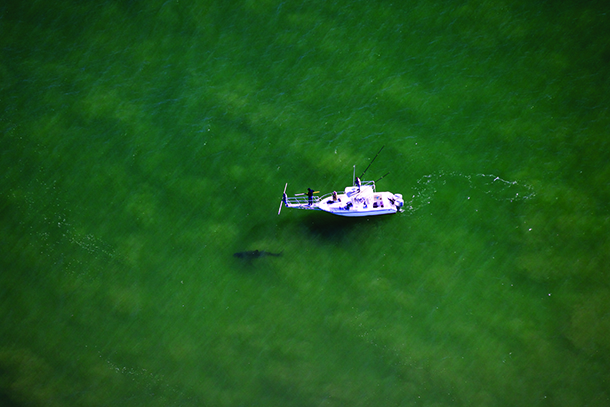
The boat that Greg Skomal and his team uses for tagging and videotaping great white sharks follows the dark shape of a shark through Cape Cod’s green waters (Photo: Keith Ellenbogen)
Scientists are tagging and videotaping Great White Sharks in the waters off Cape Cod, Massachusetts to assess this local population. For her latest book, The Great White Shark Scientist, author-adventurer Sy Montgomery followed scientist Greg Skomal in action. She tells host Steve Curwood about the charismatic sharks they found and why your toaster could be more dangerous to you than a Great White Shark.
Transcript
CURWOOD: For many humans, the Great White shark is the scariest fish in the sea, but for scientist Greg Skomal and writer Sy Montgomery those huge-jawed behemoths are simply fascinating. Sy followed Greg and his team as they searched the waters off of Cape Cod, Massachusetts for these creatures, and she tells the story in her latest book, "The Great White Shark Scientist". Sy Montgomery joins me now. Sy, welcome back to Living on Earth.
MONTGOMERY: Oh, I'm thrilled to be here again.
CURWOOD: Glad to have you. So, I've got to say it seems like finding a shark might be like finding a needle in a haystack. How does Greg Skomal do it?
MONTGOMERY: Well, it's not easy to go out and find a shark. You need to have a good enough day that both a boat and a spotter plane can go out. So he has eyes in the sky and they're looking above for the dark shape through the green murky water of a shark, and he stays in touch by radio with his pilot, Wen Davis, who tells him, “OK, this is where you going to find a shark.”Then, with an expert pilot, he goes out and they have to get right next to the shark.
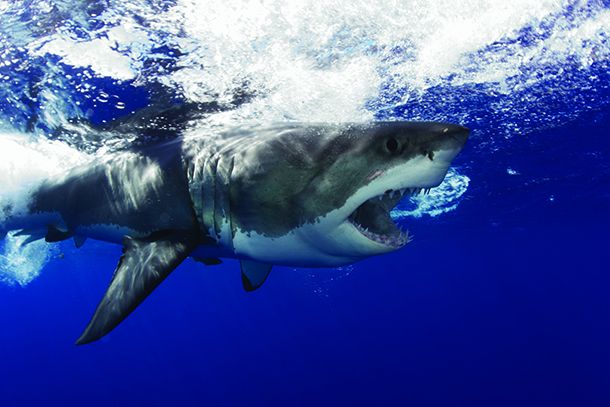
Despite sharks’ reputation as vicious creatures that will take a bite out of a human at every opportunity, perhaps our fear is a bit misplaced. Sharks of all species kill about eleven people each year, but humans kill 100 million sharks yearly. (Photo: Keith Ellenbogen)
CURWOOD: Describe for me, Sy, what exactly do they do when they find the sharks?
MONTGOMERY: When Greg finds a shark, he wants to get GoPro video of the animal from both sides, from above and below. He wants to find out how big is this animal, is it male or female - which you tell by checking underneath the tail - and you get a good shot of the distinguishing characteristics of the shark. You can tell who's who because of the distinct individual pattern where the dark part of the shark joins the light part of the shark and this is particularly easy to tell around the gills, the chin, and near the tail area.
CURWOOD: So getting this camera under the shark to get a good picture...?
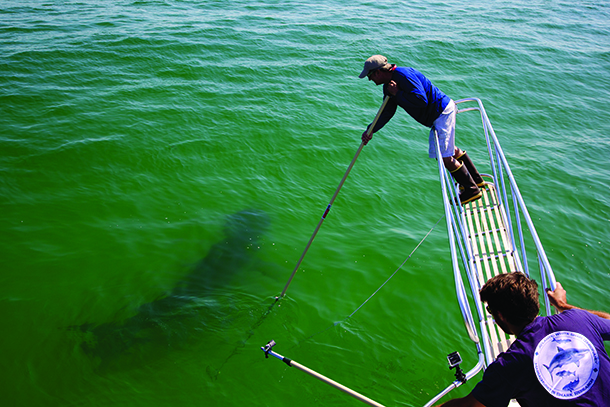
Greg leans over the “pulpit” of the research boat and sticks a GoPro camera into the water beside a great white shark. (Photo: Keith Ellenbogen)
MONTGOMERY: Right. They have it on the end of the pole, usually a pole used for a painter's brush, but it takes quite a bit of skill for Greg, who's out there on this pulpit that's built onto the front of the boat. So he's right above that shark and he's holding the pole down trying to get the right video. And you wouldn't believe it, but these really strong, huge fish are very shy. They spook easily, so it's not an easy job to find them, and once you find them getting that crucial video. They're also tagging these animals. The study that we were following, they were much more interested in doing the video than even doing the tagging because they want to know who each shark is.
CURWOOD: How exactly does this tagging process work, and what information does science get from it?
MONTGOMERY: The tags allow him to figure out who was where, when, and where do they go? Some of them are hooked up to satellites, transmitting every time the shark comes near the surface, its location, so you can plot out a map of where each shark has been. There's also a series of buoys around the Cape and when a shark swims near that buoy, he pings into that buoy so that you know what time, which shark visited that buoy. We got to meet, I think, seven different sharks on our last shark sortie, which was so thrilling. One of the ones that we met was Chex, and poor Chex had been a pincushion, he had actually been tagged a couple of different times, and we almost tagged him a third time until we realized, uh oh, it's Chex, and we don't need to tag him again.
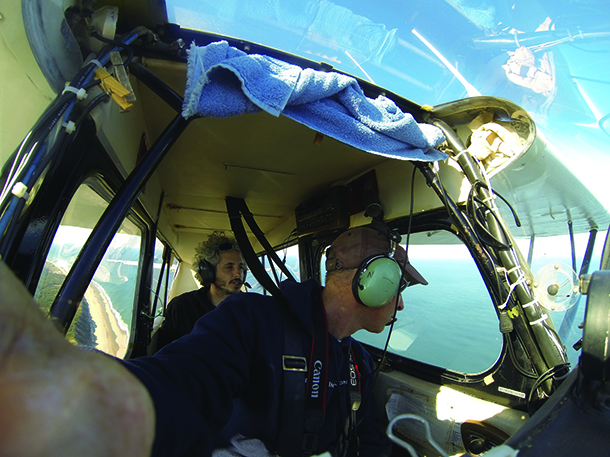
The pilot Wayne Davis and photographer Keith Ellenbogen took to the skies to search for sharks in Wayne’s Citabria. Wayne took this photo with Keith’s GoPro. (Photo: Keith Ellenbogen)
CURWOOD: Now I understand from your book, Sy, the public can look at the sharks that are tagged for the satellite.
MONTGOMERY: Well, with a smartphone, there's an app you can download and you can follow some the tagged sharks who have names like Mary Lee and Lydia, and they even have like their own Facebook page. They're like stars and people are so excited to know like Mary Lee showed up around New Jersey yesterday and oh gosh, Lydia's down in Florida, or one of them may be headed here. It's really cool to know that.
CURWOOD: Now, what's the website if you don't want to go the app way?
MONTGOMERY: It's ocearch.org. O-C-E-A-R-C-H.org.
CURWOOD: OK. Let me take a look here. Oh yeah, look at this. There is Lydia and she was last pinged yesterday oh and Helen! This is so cool. You can follow these guys in real time. Sy, truly, tell me. How frightening are these sharks for humans?
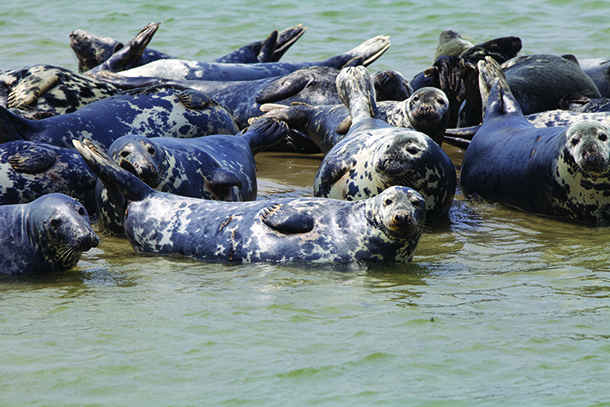
A recovering population of seals at Cape Cod appears to be drawing more sharks back to the area (Photo: Keith Ellenbogen)
MONTGOMERY: Well, I've got to say this. For this book, it's hard for Keith Ellenbogen and I also went to Mexico and we dived in a shark cage where these ways animals came within yards of us. What I felt when I saw my first Great White shark coming toward me, instead of panic was a profound sense of tranquility. When the animal looked at me, when I saw his eye swivel in its socket and look at my face, there was no malice at all. He wasn't the least bit interested in eating me, because think of it, a delicious seal with all that yummy blubber, that's like a steak and a piece of chocolate cake to a Great White shark, but me, I'm a stringy piece of celery that's been sitting out on the counter all week. They are not going to want to eat me. [CURWOOD LAUGHS] When I saw the shark coming, I felt very calm because here's this giant fish that reigned overseas for millennia, and only recently as humans have taken charge, and we've done a terrible job as you know. By 2050, the scientists tell us there's going to be more plastic in the seas than fish. But there I am, under the water, and here's someone who has done a great job for a millennia and I was just so glad to see someone showing up who knew what they were doing. And they're incredibly beautiful too. When you see them in the clear waters that you can off Guadalupe, they look like a knight in white and silver satin. I mean, they're just gorgeous, sleek, clean, perfect animals.
CURWOOD: As I understand it, in your book you say the Great White sharks particularly don't like to eat people.
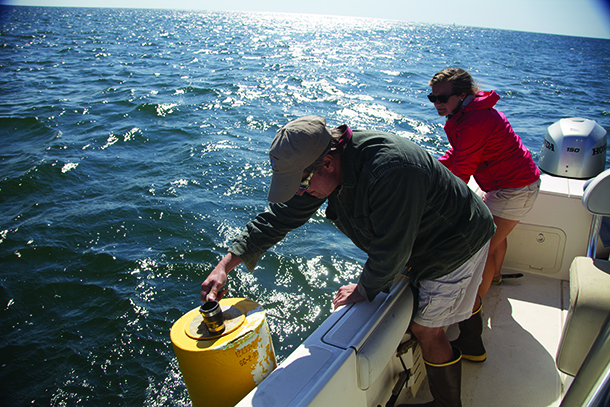
Greg pulls a receiver buoy that records which sharks came close, when, out of the water to download its data. (Photo: Keith Ellenbogen)
MONTGOMERY: Not really. I mean, when they occasionally do bite someone, they spit them out. They hardly ever eat them because it's a mistake. If you look at some of the figures, the chance of being killed by a shark of any species is 1 in 37 million. Whereas the chances that you will die of the flu is actually 1 in 63. You are far more likely to be injured by a room freshener, by a toaster or by your toilet.
CURWOOD: [LAUGHS] Whoa, wait. My toilet is going to bite me?
MONTGOMERY: Well, there's a couple things that could happen. You can get conked on the head by the seat if you're a little child, you could fall and you could drown. This is extremely rare and freakish, but more rare and freakish is a Great White shark will ever hurt you.
CURWOOD: Well, still, you don't want to tempt fate. How can people be shark smart when they are at the beach?
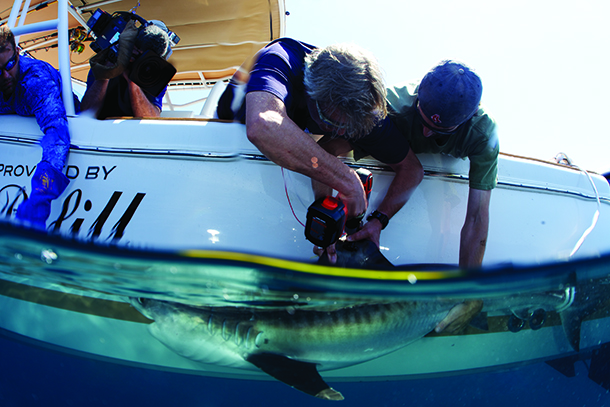
Greg tags a shark fin. The team has tied the shark to the boat by its tail to hold it in place during the tagging (Photo: Keith Ellenbogen)
MONTGOMERY: Well, one, don't swim way far out away from the beach, and don't go anywhere near the seals - it's illegal to do so anyway. And seals, have quite a set a teeth on them too. Since the Marine Mammal Protection Act of 1972, the grey seals have made a big comeback. Their numbers have swelled enormously. But they aren't on the beaches that people swim on. There was one attack on Cape Cod just a few years ago. That person was hurt, but he's absolutely fine, and it was the first attack on a person in Massachusetts in 76 years. That was in 2012, and the guy was swimming near some seals and far from shore. You know what I heard even before I met Greg? Even though I had never seen a shark at the beach, sharks see us all the time and swim right by.
CURWOOD: Sy, how many of the Great White sharks are there around the planet these days and how threatened are they as a species?
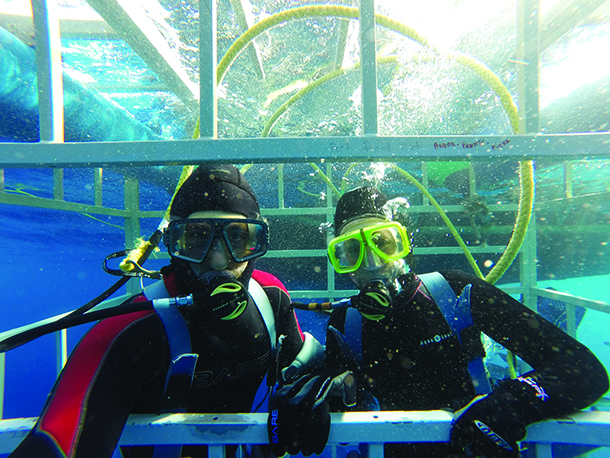
Sy, right, and photographer Keith Ellenbogen went scuba diving in a shark cage off the coast of Mexico. (Photo: Keith Ellenbogen)
MONTGOMERY: We don't know. It is believed that Great White sharks are not endangered. There's other species of sharks that are endangered. Often they're endangered because of the horrible practice of finning, to take the fins for shark fin soup this is a dreadful thing. The animal is fished out of the water, you chop of its dorsal fin and you dump the animal bleeding to die back in the ocean. Other sharks are targeted specifically because people fear and hate them and they're just killed because they a good shark is a dead shark. And this is a really dangerous view because when you start messing with the numbers of apex predators you wreck the whole balance of the ocean. In other areas where this has been done and shark numbers have collapsed, it has created but you call a trophic cascade of disaster all the way down to where the quality of the water actually suffers.
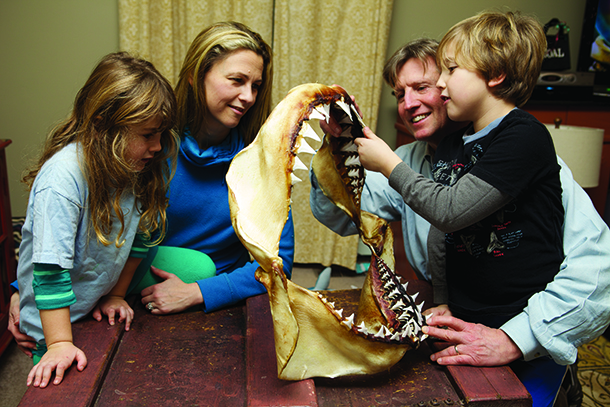
Shark scientist Greg Skomal and his family marvel at the size of a great white shark jaw (Photo: Keith Ellenbogen)
CURWOOD: Really.
MONTGOMERY: It messes up the whole ecosystem. One place where sharks were targeted specifically, and their number started to collapse. It killed the entire scallop industry for that area. Sharks keep the predators of the scallops numbers in order, and once you wreck that balance you can lose an entire fishery and because scallops are filter feeders, it wrecks the quality of water. That's what happens when we knock out one of those building blocks that's supporting the health of our seas.
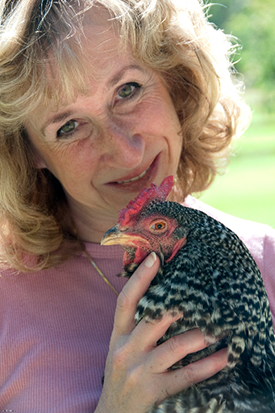
Sy Montgomery is the author of over twenty books on wildlife for children and adults (Photo: courtesy of Sy Montgomery)
CURWOOD: What's the most surprising thing, Sy, that you learned about sharks in the course of writing this book?
MONTGOMERY: Just everything about them I think is pretty thrilling. I love knowing how many teeth these guys have, and how many they grow throughout their lives. A shark can produce 30,000 teeth in its lifetime, which explains why there's so many fossilized shark teeth floating around. Also, I was surprised to learn the age to which a Great White can live. Their life spans are similar to ours. They can live for 70 years.
CURWOOD: Sy Montgomery is the author of "The Great White Shark Scientist" and over 20 other books. And this one she did with photographer Keith Ellenbogen. Thanks so much, Sy, for taking the time.
MONTGOMERY: Thanks you, Steve, it was a pleasure.
Links
Sy Montgomery’s book, The Great White Shark Scientist
Track tagged Great White sharks and other marine animals on Ocearch
Atlantic White Shark Conservancy
Greg Skomal’s shark research for the Massachusetts Department of Marine Fisheries
“Rethink the Shark”: Watch the humorous TV ads created to debunk shark risks
Living on Earth wants to hear from you!
Living on Earth
62 Calef Highway, Suite 212
Lee, NH 03861
Telephone: 617-287-4121
E-mail: comments@loe.org
Newsletter [Click here]
Donate to Living on Earth!
Living on Earth is an independent media program and relies entirely on contributions from listeners and institutions supporting public service. Please donate now to preserve an independent environmental voice.
NewsletterLiving on Earth offers a weekly delivery of the show's rundown to your mailbox. Sign up for our newsletter today!
 Sailors For The Sea: Be the change you want to sea.
Sailors For The Sea: Be the change you want to sea.
 The Grantham Foundation for the Protection of the Environment: Committed to protecting and improving the health of the global environment.
The Grantham Foundation for the Protection of the Environment: Committed to protecting and improving the health of the global environment.
 Contribute to Living on Earth and receive, as our gift to you, an archival print of one of Mark Seth Lender's extraordinary wildlife photographs. Follow the link to see Mark's current collection of photographs.
Contribute to Living on Earth and receive, as our gift to you, an archival print of one of Mark Seth Lender's extraordinary wildlife photographs. Follow the link to see Mark's current collection of photographs.
 Buy a signed copy of Mark Seth Lender's book Smeagull the Seagull & support Living on Earth
Buy a signed copy of Mark Seth Lender's book Smeagull the Seagull & support Living on Earth

